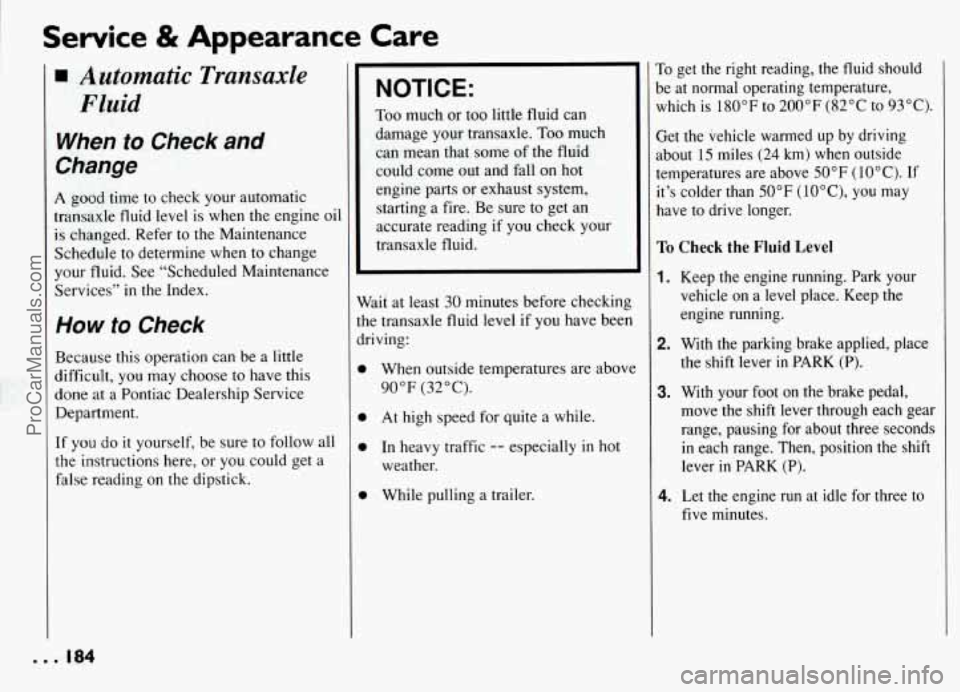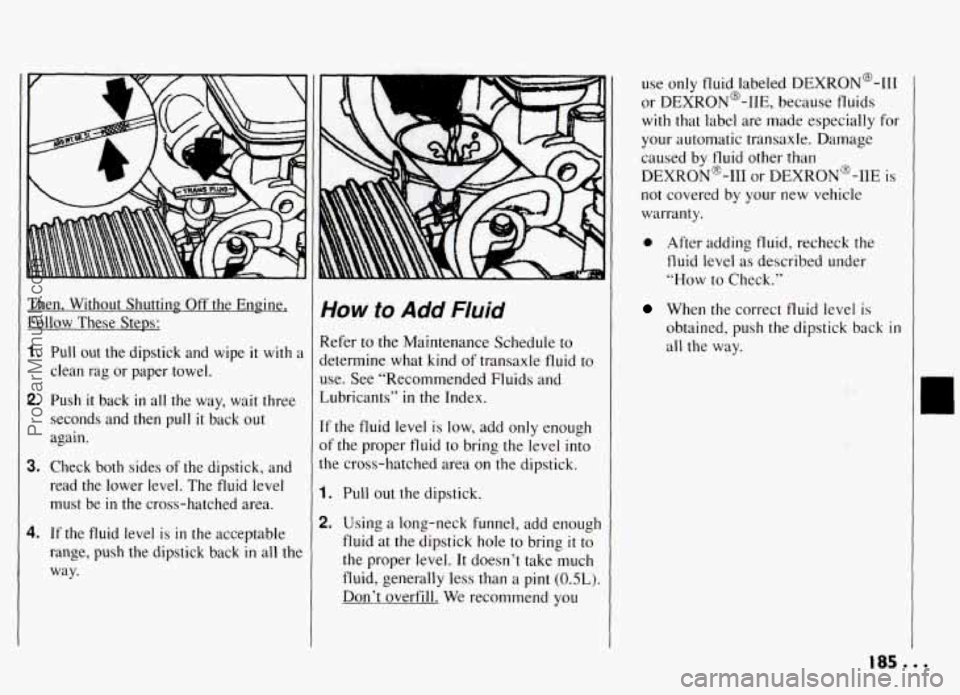Page 135 of 274

Your Driving and the Road
Highway Hypnosis
Is there actually such a condition as
“highway hypnosis”? Or is it just plain
falling asleep at the wheel? Call it
highway hypnosis, lack of awareness, or
whatever.’
There is something about an easy stretch
of road with the same scenery, along with
the hum of the tires on the road, the drone
of the engine, and the rush of the wind
against the vehicle that can make you
sleepy. Don’t let it happen to you! If it
does, your vehicle can leave the road in
less than a second, and you could crash
and
be injured.
What can you do about highway
hypnosis? First, be aware that it can
happen.
Second, here are some tips:
Make sure your vehicle is well
ventilated, with a comfortably cool
interior.
Keep your eyes moving. Scan the road
ahead and to the sides. Check your
rearview mirrors and your instruments
frequently.
If you get sleepy, pull off the road into
a rest, service, or parking area and
take a nap, get some exercise, or both.
For safety, treat drowsiness on the
highway as an emergency.
Hill and Mountain
Roads
Driving on steep hills or mountains is
different from driving in flat or rolling
terrain.
If you drive regularly in steep country, or
if you’re planning
to visit there, here are
some tips that can make your trips safer
and more enjoyable.
0 Keep your vehicle in good shape. Check all fluid levels and also the
brakes, tires, cooling system and
transaxle. These parts can work hard
on mountain roads.
ProCarManuals.com
Page 147 of 274
Your Driving and the Road
Maintenance When Trailer
Towing
Your vehicle will need service more often
when you’re pulling a trailer. See the
Maintenance Schedule for more on this.
Things that are especially important in
trailer operation are automatic transaxle
fluid (don’t overfill), engine oil, belts,
cooling system, and brake adjustment.
Each of these is co%ered in this manual,
and the Index will help you find them
quickly. If you’re trailering, it’s a good
idea to review these sections before
you
start your .trip.
Check periodically to see that all hitch
b e 146
ProCarManuals.com
Page 151 of 274
Problems on the Road
To Jump Start Your
Pontiac: (CONK)
5. Check that the jumper cables don’t
have loose or missing insulation.
If
they do, you could get a shock. The
vehicle? could be damaged, too.
Before you connect the cables, here
are some basic things
you should
know. Positive
(+) will go to positive
(+) and negative (-) will go to negative
(-) or a metal engine part.
Don’t connect (+) to (-) or you’ll get a
short that would damage the battery
and maybe other parts, too.
6. Connect the red positive (+) cable to
the positive (+) terminal of the vehicle
with the dead battery.
Use a remote positive (+) terminal if
the vehicle has one.
ProCarManuals.com
Page 159 of 274
Problems on the Road
1 Cooling System (CONK)
If the coolant inside the coolant surge
tank is boiling, don’t do anything else
until it cools down. The coolant level should be at or above
FULL COLD. If it isn’t, you may have a
leak in the radiator hoses, heater hoses,
radiator, water pump or somewhere else
in the cooling system. ~~~
NOTICE:
Engine
damage from running your
engine without coolant isn’t covered
by your warranty.
If there seems to be no leak, check to see
if the electric engine fan is running. If the
engine is overheating, the fan should be
running. If it isn’t, your vehicle needs
service.
e e e 158
ProCarManuals.com
Page 174 of 274

Gasolines for Cleaner Air
Your use of gasoline with deposit control
additives will help prevent deposits from
forming in your engine and fuel system.
That helps keep your engine in tune and
your emission control system working
properly. It’s good for your vehicle, and
you’ll be doing your part for cleaner air.
Many gasolines are now blended with
oxygenates. General Motors recommends
that you use gasolines with these blending
materials, such as MTBE and ethanol. By
doing
so, you can help clean the air,
especially in those parts of the country
that have high carbon monoxide levels.
[n addition, some gasoline suppliers are
now producing reformulated gasolines.
These gasolines are specially designed to
reduce vehicle emissions. General Motors
recommends that you use reformulated
gasoline. By doing
so, you can help clean
the air, especially in those parts of the
zountry that have high ozone levels.
You should ask your service station
lperators
if their gasolines contain deposit
zontrol additives and oxygenates, and if
:hey have been reformulated to reduce
fehicle emissions.
Fuels in Foreign
Countries
If you plan on driving in another country
outside the
U.S. or Canada, unleaded fuel
may be hard to find. Do not use leaded
gasoline. If you use even one tankful,
your emission controls won’t work well
or at all. With continuous use, spark plugs
can get fouled, the exhaust system can
corrode, and your engine oil can
deteriorate quickly. Your vehicle’s oxygen
sensor will be damaged. All of that means
costly repairs that wouldn’t be covered by
your warranty.
To check on fuel availability, ask an auto
club, or contact a major oil company that
does business in the country where you’ll
be driving.
You can also write us at the following
address for advice. Just tell
us where
you’re going and give your Vehicle
Identification Number
(VIN).
General Motors Overseas Distribution
Corporation,
North American Export Sales (NAES)
1908 Colonel Sam Drive
Oshawa, Ontario
L 1 H 8P7
173...
ProCarManuals.com
Page 180 of 274

Engine Oil
If the CHECK OIL light on the
instrument panel comes on,
it means you
need to check your engine oil level right
away. For more information, see “Check
Oil Light”
in the Index. You should check
the engine
oil regularly; this is an added
reminder.
It’s a good idea to check your engine oil
every time you get fuel. In order to get an
accurate reading, the oil must be warm
and the vehicle must be on level ground.
Turn off the engine and give the oil a few
minutes to drain back into the oil pan.
If
you don’t, the oil dipstick might not show
the actual level.
To Check Engine Oil
Pull out the dipstick and clean it with a
paper towel or cloth, then push
it back in
all the way. Remove it again, keeping the
tip lower, and check the level.
When to Add Oil
If the oil is at or below the ADD line, then
you’ll need to add some oil. But
you must
use the right kind. This section explains
what kind of oil
to use. For crankcase
capacity, see “Capacities and
Specifications” in the Index.
Adding Engine Oil
Just fill it enough to put the level
somewhere
in the proper operating range.
Push the dipstick all the way back
in
when you are through.
NOTICE:
Don’t add too much oil. If your
engine has
so much oil that the oil
level gets above the cross-hatched
area that shows the proper operating
range, your engine could
be
damaged.
179. . .
ProCarManuals.com
Page 185 of 274

Service & Appearance Care
Automatic Transaxle Fluid
When to Check and
Change
A good time to check your automatic
transaxle fluid level is when the engine oil
is changed. Refer to the Maintenance
Schedule to determine when to change
your fluid. See “Scheduled Maintenance
Services” in the Index.
How to Check
Because this operation can be a little
difficult, you may choose
to have this
done at a Pontiac Dealership Service
Department.
If you do it yourself, be sure to follow all
the instructions here, or you could get a
false reading on the dipstick.
NOTICE:
Too much or too little fluid can
damage your transaxle.
Too much
can mean that some of the fluid
could come out and fall on hot
engine parts or exhaust system,
starting a fire. Be sure
to get an
accurate reading if you check your
transaxle fluid.
Wait at least 30 minutes before checking
the transaxle fluid level
if you have been
driving:
0 When outside temperatures are above
90°F (32°C).
0 At high speed for quite a while.
0 In heavy traffic -- especially in hot
weather.
0 While pulling a trailer.
To get the right reading, the fluid should
,e at normal operating temperature,
which is 180°F to 200°F (82°C to 93°C).
Set the vehicle warmed up by driving
ibout 15 miles
(24 km) when outside
iemperatures are above
50°F (10°C). If
it’s colder than 50°F
(IOOC), you may
have to drive longer.
To Check the Fluid Level
1. Keep the engine running. Park your
vehicle on a level place. Keep the
engine running.
2. With the parking brake applied, place
the shift lever in PARK (P).
3. With your foot on the brake pedal,
move the shift lever through each gear
range, pausing for about three seconds
in each range. Then, position the shift
lever in PARK
(P).
4. Let the engine run at idle for three to
five minutes.
ProCarManuals.com
Page 186 of 274

Then, Without Shutting Off the Engine,
Follow These Steps:
1. Pull out the dipstick and wipe it with a
clean rag or paper towel.
2. Push it back in all the way, wait three
seconds and then
pull it back out
again.
3. Check both sides of the dipstick, and
read the lower level. The fluid level
must be
in the cross-hatched area.
4. If the fluid level is in the acceptable
range, push the dipstick back in all the
way.
How to Add Fluid
Refer to the Maintenance Schedule to
determine what kind
of transaxle fluid to
use. See “Recommended Fluids and
Lubricants”
in the Index.
[f the fluid level is low, add only enough
of the proper fluid to bring the level into
the cross-hatched area on the dipstick.
1. Pull out the dipstick.
2. Using a long-neck funnel, add enough
fluid at the dipstick hole to bring it to
the proper level. It doesn’t take much
fluid, generally less than a pint
(OSL).
Don’t overfill. We recommend you
use only fluid labeled DEXRON@-111
or DEXRON@-IIE, because fluids with that label are made especially for
your automatic transaxle. Damage
caused by
fluid other than
DEXRON@-111 or DEXRON@-IIE is
not covered by your new vehicle
warranty.
0 After adding fluid, recheck the
fluid level as described under
“How
to Check.”
When the correct fluid level is
obtained, push the dipstick back in
all the way.
,. .. .. . ?!;i
.. !f ;
. : .
:,$ t * L .. ,, , ,, i
I85
ProCarManuals.com